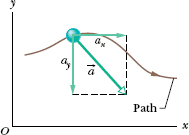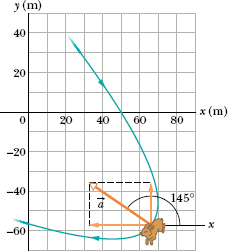When a particle’s velocity changes from  1 to
1 to  2 in a time interval Δt, its average acceleration
2 in a time interval Δt, its average acceleration ![]() during Δt is
during Δt is

If we shrink Δt to zero about some instant, then in the limit ![]() approaches the instantaneous acceleration (or acceleration)
approaches the instantaneous acceleration (or acceleration) ![]() at that instant; that is,
at that instant; that is,

If the velocity changes in either magnitude or direction (or both), the particle must have an acceleration.
We can write Eq. 4-16 in unit-vector form by substituting Eq. 4-11 for  to obtain
to obtain

We can rewrite this as

where the scalar components of ![]() are
are

Thus, we can find the scalar components of ![]() by differentiating the scalar components of
by differentiating the scalar components of  .
.
Figure 4-7 shows an acceleration vector ![]() and its scalar components for a particle moving in two dimensions. Caution: When an acceleration vector is drawn, as in Fig. 4-7, it does not extend from one position to another. Rather, it shows the direction of acceleration for a particle located at its tail, and its length (representing the acceleration magnitude) can be drawn to any scale.
and its scalar components for a particle moving in two dimensions. Caution: When an acceleration vector is drawn, as in Fig. 4-7, it does not extend from one position to another. Rather, it shows the direction of acceleration for a particle located at its tail, and its length (representing the acceleration magnitude) can be drawn to any scale.

Fig. 4-7 The acceleration ![]() of a particle and the scalar components of
of a particle and the scalar components of ![]() .
.
For the rabbit in Sample Problems 4-2 and 4-3, find the acceleration ![]() at time t = 15 s, in unit-vector notation and in magnitude-angle notation.
at time t = 15 s, in unit-vector notation and in magnitude-angle notation.
Solution: There are two Key Ideas here: (1) We can find the rabbit’s acceleration ![]() by first finding the acceleration components. (2) We can find those components by taking derivatives of the rabbit’s velocity components. Applying the ax part of Eq. 4-18 to Eq. 4-13, we find the x component of
by first finding the acceleration components. (2) We can find those components by taking derivatives of the rabbit’s velocity components. Applying the ax part of Eq. 4-18 to Eq. 4-13, we find the x component of ![]() to be
to be

Similarly, applying the ay part of Eq. 4-18 to Eq. 4-14 yields the y component as

We see that the acceleration does not vary with time (it is a constant) because the time variable t does not appear in the expression for either acceleration component. Equation 4-17 then yields

which is shown superimposed on the rabbit’s path in Fig. 4-8.

Fig. 4-8 The acceleration ![]() of the rabbit at t = 15 s. The rabbit happens to have this same acceleration at all points on its path.
of the rabbit at t = 15 s. The rabbit happens to have this same acceleration at all points on its path.
To get the magnitude and angle of ![]() , either we use a vector-capable calculator or we follow Eq. 3-6. For the magnitude we have
, either we use a vector-capable calculator or we follow Eq. 3-6. For the magnitude we have

For the angle we have

However, this angle, which is the one displayed on a calculator, indicates that ![]() is directed to the right and downward in Fig. 4-8. Yet, we know from the components that
is directed to the right and downward in Fig. 4-8. Yet, we know from the components that ![]() must be directed to the left and upward. To find the other angle that has the same tangent as −35° but is not displayed on a calculator, we add 180°:
must be directed to the left and upward. To find the other angle that has the same tangent as −35° but is not displayed on a calculator, we add 180°:

This is consistent with the components of ![]() . Note that
. Note that ![]() has the same magnitude and direction throughout the rabbit’s run because, as we noted previously, the acceleration is constant.
has the same magnitude and direction throughout the rabbit’s run because, as we noted previously, the acceleration is constant.
![]() CHECKPOINT 3 Here are four descriptions of the position (in meters) of a puck as it moves in an xy plane:
CHECKPOINT 3 Here are four descriptions of the position (in meters) of a puck as it moves in an xy plane:

For each description, determine whether the x and y components of the puck’s acceleration are constant and whether the acceleration ![]() is constant.
is constant.
A particle with velocity ![]() (in meters per second) at t = 0 undergoes a constant acceleration
(in meters per second) at t = 0 undergoes a constant acceleration ![]() of magnitude a = 3.0 m/s2 at an angle θ = 130° from the positive direction of the x axis. What is the particle’s velocity
of magnitude a = 3.0 m/s2 at an angle θ = 130° from the positive direction of the x axis. What is the particle’s velocity  at t = 5.0 s, in unit-vector notation and in magnitude-angle notation?
at t = 5.0 s, in unit-vector notation and in magnitude-angle notation?
Solution: We first note that this is two-dimensional motion, in the xy plane. Then there are two Key Ideas here. First, because the acceleration is constant, Eq. 2-11 (v = v0 + at) applies. Second, because Eq. 2-11 applies only to straight-line motion, we must apply it separately for motion parallel to the x axis and motion parallel to the y axis; that is, we must find the velocity components vx and vy from the equations

In these equations, v0x (= −2.0 m/s) and v0y (= 4.0 m/s) are the x and y components of ![]() , and ax and ay are the x and y components of
, and ax and ay are the x and y components of ![]() . To find ax and ay, we resolve
. To find ax and ay, we resolve ![]() either with a vector-capable calculator or with Eq. 3-5:
either with a vector-capable calculator or with Eq. 3-5:
ax = a cos θ = (3.0 m/s2)(cos 130°) = −1.93 m/s2,
ay = a sin θ = (3.0 m/s2)(sin 130°) = +2.30 m/s2.
When these values are inserted into the equations for vx and vy, we find that, at time t = 5.0 s,
vx = −2.0 m/s + (−1.93 m/s2)(5.0 s) = −11.65 m/s,
vy = 4.0 m/s + (2.30 m/s2)(5.0 s) = 15.50 m/s.
Thus, at t = 5.0 s, we have, after rounding to the correct number of significant figures,

Either using a vector-capable calculator or following Eq. 3-6, we find that the magnitude and angle of  are
are

Check the last line with your calculator. Does 127° appear on the display, or does −53° appear? Now sketch the vector  with its components to see which angle is reasonable.
with its components to see which angle is reasonable.
![]() CHECKPOINT 4 If the position of a hobo’s marble is given by
CHECKPOINT 4 If the position of a hobo’s marble is given by ![]() , with
, with ![]() in meters and t in seconds, what must be the units of the coefficients 4, −2, and 3?
in meters and t in seconds, what must be the units of the coefficients 4, −2, and 3?
Leave a Reply